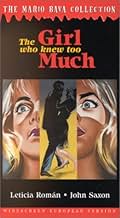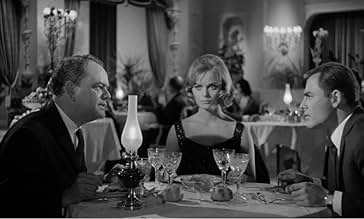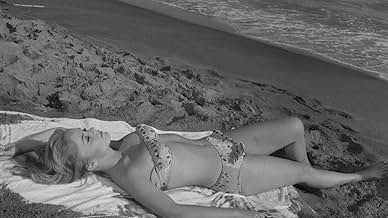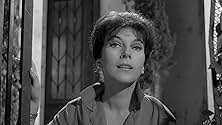En vacances à Rome, Nora Davis assiste impuissante à un meurtre. Personne ne croyant son témoignage, elle se met à accumuler les indices afin de prouver sa bonne foi. Ce jeu de piste la met ... Tout lireEn vacances à Rome, Nora Davis assiste impuissante à un meurtre. Personne ne croyant son témoignage, elle se met à accumuler les indices afin de prouver sa bonne foi. Ce jeu de piste la met sur la voie de la prochaine victime: elle-même.En vacances à Rome, Nora Davis assiste impuissante à un meurtre. Personne ne croyant son témoignage, elle se met à accumuler les indices afin de prouver sa bonne foi. Ce jeu de piste la met sur la voie de la prochaine victime: elle-même.
- Réalisation
- Scénario
- Casting principal
- Récompenses
- 1 victoire et 1 nomination au total
- Nora Davis
- (as Leticia Roman)
- …
- Dr. Alessi
- (as Robert Buchanan)
- Professor Torrani
- (as Gianni De Benedetto)
- Andrea Landini
- (as Dante Di Paolo)
- Uncle Augusto
- (non crédité)
- Asylum employee
- (non crédité)
- Woman in Sguattera Restaurant
- (non crédité)
Avis à la une
This is no doubt the first giallo film and the last film Bava shot in black and white.
It is very mild when it comes to the gore n it aint scary but a bit comedic n predictable if u pay attention.
The movie plays more like a Hitchcockian thriller and it is obvious that this movie is one genius' homage to another genius.
I enjoyed this even more as i am a big fan of Saxon and his character is one of the suspect. The beach scene is hilarious.
The scene wher the priest picks up the cigarette laden with marijuana is epic.
Bava's cinematography is once again splendid.
The Piazza di Spagna n Spanish steps are captured very well.
Bava is so precise with the direction. After the murder there is rain, so one can't look for blood.
Also when the lead female is trying to recollect the murder n just when she is about to recollect the knife thrown by the killer, she is distracted by the gun shots (kid's toys) n she forgets.
P. S. In the Italian Version, Nora and Marcello are standing at an overlook, trying to forget what happened, planning their wedding. When Marcello wants to light a cigarette Nora got out of her purse, she starts thinking that it was all in her head as a result of smoking weed. She tosses the spliffs and a reverend picks them up. Now the word "FINE" appears on the screen.
In the US Version, a man with binoculars gets in a chair lift in order to shoot a woman. Nora and Marcello are in another chair lift and witness the entire thing. They are talking about getting married as well, but Marcello wishes that Nora would never ever start with any kind of crimes or murders.
As the title suggests, The Girl Who Knew Too Much is indebted to Alfred Hitchcock more than anything else. The idea of an innocent thrust into the middle of a deadly situation is one Hitchcock used many times. While the romantic sub-plot and moments of light comedy also recall his work. These latter two elements are mainly what mark out TGWKTM as a cross-over film, as they are certainly not features of giallo cinema as it would develop. But the light, comic approach is one of the things that make this one of the most playful and upbeat films that Mario Bava ever made. Unlike his three other gialli, this film actually has sympathetic characters. While it doesn't have the melodramatic tendencies that those ensemble movies had either. The approach is much more restrained, with a fairly simple amateur sleuth narrative being the framework. Completely different too is the black and white aesthetic. Bava is of course rightfully famous for his masterful use of colour but in this film he shows that his use of light and contrast is just as impressive. This is a very handsome looking movie. Letícia Román adds to this aesthetic too of course, seeing as she is a very beautiful woman. Visually, this is a terrific film. Story-wise, it's certainly less interesting. The fairly mechanical plot is sufficient enough in taking us from A to B but it isn't particularly memorable. But it does introduce some of the motives that would go on to form an important part of giallo cinema such as the convoluted mystery, the bizarre reasoning for murder and the importance of optical subjectivity as well as the focus on style over substance.
The Girl Who Knew Too Much is a film that should be seen by fans of Mario Bava as well as dedicated students of all things giallo. It's a film that is as breezy and light as the genre ever got. It's a lovely and beautiful looking flick from a master film-maker.
Anyway, I don't know whether it's because I preceded it with Riccardo Freda's delirious and luridly-colored THE GHOST (1963) or the fact that the film retains an incongruous light touch (and leisurely pace) throughout – including the heroine's ruse to ensnare her stalker by the unlikely methods adopted in the pulp thrillers she avidly reads – but, while I enjoyed it a good deal, it felt to me like an altogether minor work from the maestro! Similarly, the murder sequences – a stylized highlight of later giallos – are pretty mild here. Still, Bava's consistent virtues – as a director – for creating tremendous suspense and the fantastic lighting and crisp cinematography that come with his intimate knowledge of the camera are well in evidence.
The first half-hour is pretty busy plot-wise, as all sorts of things happen to the charming leading lady (the striking-looking Leticia Roman, daughter of Oscar-winning costume designer Vittorio Nino Novarese): first she gets involved with a drug-dealer, then the old woman she was to live with dies on her, after which she roams outside in a frenzied state to be held up by a small-time crook and witness a knife-murder across Rome's famous Piazza di Spagna! Her disoriented frame-of-mind is effectively rendered by Bava through simple expedients, such as distorting lenses and focus-pulling. Incidentally, the foreigner-investigating-a-series-of-murders-in-Italy plot line prefigures such notable Dario Argento films as THE BIRD WITH THE CRYSTAL PLUMAGE (1970) and DEEP RED (1975). Interestingly, since there was no yardstick for the genre as yet, Bava relied on such familiar film noir trappings as first-person narration to push the story forward.
The film also features a young John Saxon in his first of many "Euro-Cult" outings as Roman's boyfriend and Valentina Cortese as her wealthy, eccentric landlady; the script provides plenty of suspects, but the final revelation comes as a surprise (though, in hindsight, it seems pretty obvious) – and this is followed by a lengthy explanation of the motive behind the killings, which became a standard 'curtain' for this type of thriller. There's an amusing final gag involving a packet of cigarettes and a priest, while Adriano Celentano's catchy pop song "Furore" serves as a motif during the course of the film.
Additional footage was prepared for the U.S. version (snippets of which are present in the accompanying trailer), while the title was changed to THE EVIL EYE and Roberto Nicolosi's score replaced with that of Les Baxter (as had already proved to be the case with Bava's BLACK Sunday [1960])! It would have been nice to have had this cut of the film (which is said to stress the comedy even more) included for the sake of comparison – and it had actually been part of the original announcement for "The Mario Bava Collection Vol. 1", along with the similar AIP variants for BLACK Sunday itself and BLACK SABBATH (1963), but these were subsequently retracted! Incidentally, I now regret not renting the alternate version of THE GIRL WHO KNEW TOO MUCH on DVD-R while I was in Hollywood – but, back then, I wanted first to watch the film as the director intended.
In John Saxon's otherwise entertaining interview on the Anchor Bay DVD (in which he recounts his experience working on this film and other stuff he made during his tenure in Italy), he erroneously mentions that he worked with director Lucio Fulci – whose name he even mispronounces as Luciano! Despite there being a considerable amount of dead air throughout Tim Lucas' Audio Commentary, it does a wonderful job at detailing the film's background – plus offering his own take on events: it does prove enlightening on several aspects of the film I had initially overlooked, such as how the costumes were carefully chosen to define character or the impressive contribution given by Dante di Paolo (George Clooney's uncle!) as the dour journalist investigating the murder spree. Surprisingly, Lucas also mentions that some of Bava's camera moves are more elaborate and graceful as seen in THE EVIL EYE (which makes me want to see it even more!) – but, then, important dialogue stretches heard in the Italian original involving the creepily asexual voice of the killer were bafflingly left out of the American version!!
I finally got to watch this in the way of the relatively cheap French DVD-release LA FILLE QUI EN SAVANT TROP, which includes Bava's original Italian cut as well as the American cut (titled THE EVIL EYE), which has a completely different ending and excludes some references to marijuana, as well as a stronger emphasis on the romantic plot line between the two leads John Saxon and Letícia Román, reputedly to make the film more marketable for children(!), which I find impossible to comprehend, but apparently this was what U.S. distributors had in mind. Furthermore, a bombastic Les Baxter score was added, a common treatment for most U.S releases of Italian films in that period, instead of the charming jazzy score in the Italian version (and a very catchy theme song).
Letícia Román stars as a young American woman who loves reading mystery novels. In fact, she's seen reading a detective novel called "The Knife" when we meet her on the plane. She plans to stay with her aged aunt, but one evening, the old lady dies before her eyes. When she stumbles upon the streets, she witnesses a woman stabbed to death in front of the Spanish Steps and suspects it's the work of a serial killer. Going unconscious, she awakens in the hospital and tries to convince everyone she witnessed a murder, but since no body was found, nobody believes her. She does convince a young doctor (John Saxon) to help her investigate the murders, and they soon find out a series of murders was committed ten years ago, the "Alphabet Murders." She realizes that previous victims had surnames beginning A, B and C and, because her name starts with a D, she could be the next victim.
This is often cited as the first Giallo, that specific Italian breed of thriller, named after the line of books with yellow covers, hence Giallo, Italian for yellow. THE GIRL WHO KNEW TOO MUCH basically contains most core elements attributed to this particular cinematic sub-genre, with the prime motive of the helpless heroine subjected to all kinds of dangers and physical as well as mental abuse. Nora Davis is seen reading a Giallo novel on the airplane; the foreigner as vulnerable outsider in Italy; an obsession with travel and tourism, the first murder takes place before the Spanish Steps, but the film shows countless tourist hotspots throughout Rome, and the fascination with fashion and style or the jet-set in general. Although it would take Bava's own BLOOD AND BLACK LACE (1964), lavishly shot in colour, to introduce the more elaborate, lengthy and - above all - much more violent and bloody killing sequences which would typify many later Giallos, carried out by the archetype Giallo killer with gloves and black raincoat. Wide-eyed Letícia Román is the kind of innocent looking girl with just the right combination of sexiness and innocence to pass as a very likable heroine, perhaps a touch too innocent and certainly worlds away from the sexually liberated female in later Giallos.
Early sixties' fashions and habits abound, such as Nora Davis' exuberant snake leather jacket. There's also a lot of smoking on the plane and later on Nora condones Marcello's smoking habits claiming it's bad for his health, which is presented as the audience is supposed to laugh at her "preposterous" observation, instead of Marcello's smoking habit. Typical role reversal. There's also the running gag with marijuana. In the first scene, the man next to Nora on the plane turns out to be a marijuana smuggler, but on arrival in Rome, the always alert Italian police is quick to take this character into custody. Perhaps Bava's way of saying the Italian police is always on top of these issues and malicious elements from abroad are dealt with in proper fashion.
Masterfully shot in black-and-white, the film doesn't contain the outrageous imagery of THE BODY AND THE WHIP (1963) and BLOOD AND BLACK LACE, both sumptuously shot in colour, and certainly is much lighter in tone with the sadistic bloodletting so typical of that other pivotal entry in the development of the Giallo, BLOOD AND BLACK LACE, largely lacking. Originally, it was conceived as a romantic comedy and - hence the title - as a light parody on Hitchcock's work, but Bava decided to put a larger emphasis on the more horrific elements of the story, but doesn't lose sight of the plot development, which I always found a major demerit of BLOOD AND BLACK LACE. A bit old-fashioned perhaps by American or British standards, but combining these elements with a more typical Italian tone, Bava does create something new here. Nevertheless, the tone remains conspicuously breezy and that's probably why this film turns out to be such an endearing mixture of clever Hitchcockian suspense and the occasional comedy relief. Perhaps a bit too cutesy and innocent for many Bava-fans, but I found his a thoroughly enjoyable film.
Camera Obscura --- 8/10
As the title imples, The Girl Who Knew Too Much is with one foot firmly set in Hitchcock territory, but whereas Hitch films had a tendency of trying to be too many things at once (little bits of comedy, romance etc) something I always considered distracting, Bava allows nothing to come between him and his goal: a suspenseful horror thriller.
The chiaroscuro photography is simply beautiful to look at, light and shadow play off each other in expressive ways, not unlike film-noir. Leticia Roman's face is at times only half-lit to stress her confusion, while in other set-pieces dark figures stand out against fully lit backgrounds. Bava is famous for being one of the best visual directors in the history of the medium for good reason. His black and white work is as good as his colour films.
Minor quibbles I had with the film include that many scares turn out to be false, the first person narration (another film-noir influence) and the implied possibilities in the ending *was it all a dream?* Leticia Roman and John Saxon hit it off with great chemistry, the DP work is fantabulous, the opening 15-20 minutes leading up to the first murder are among the best 20 minutes in 60's horror and this an all around accomplished horror film that deserves every fan's attention.
Le saviez-vous
- AnecdotesMario Bava was a big fan of Alfred Hitchcock, and Hitchcockian touches abound in the film, including a cameo by the director. In the scene where Letícia Román is in her bedroom at Ethel's home, the portrait on the wall with the eyes that keep following her is that of Mario Bava.
- GaffesWhen Nora answers the phone in the Torrani house, "hello" is heard before she speaks, even while the receiver is being lifted to her mouth.
- Citations
Nora Davis: [into the phone] Oh mother, murders don't just happen like that here.
- Versions alternativesAIP released this as The Evil Eye, a recut version with material used just in some countries out of Italy.
- ConnexionsFeatured in Mario Bava: Maestro of the Macabre (2000)
- Bandes originalesFurore
(Appears in the Italian version)
Sung by Adriano Celentano
Written and Composed by Adriano Celentano (as Adicel) and Piero Vivarelli (as Vivarelli)
Published by Edizioni Nazionalmusic and Disco Jolly
Meilleurs choix
- How long is The Evil Eye?Alimenté par Alexa
Détails
- Date de sortie
- Pays d’origine
- Langues
- Aussi connu sous le nom de
- The Evil Eye
- Lieux de tournage
- Sociétés de production
- Voir plus de crédits d'entreprise sur IMDbPro
- Durée1 heure 28 minutes
- Couleur
- Mixage
- Rapport de forme
- 1.66 : 1
Contribuer à cette page


















